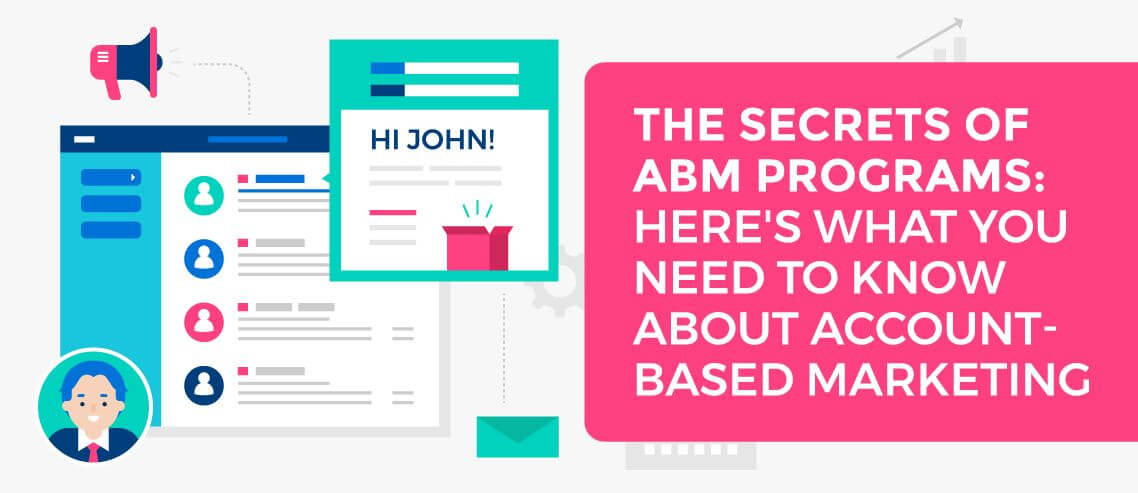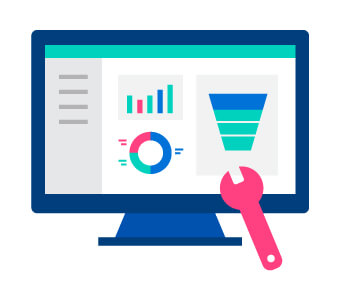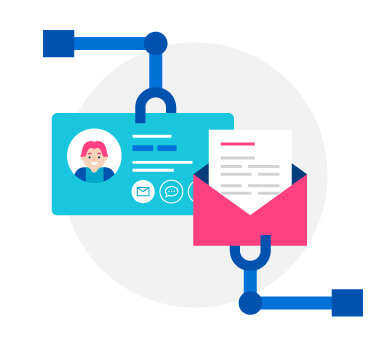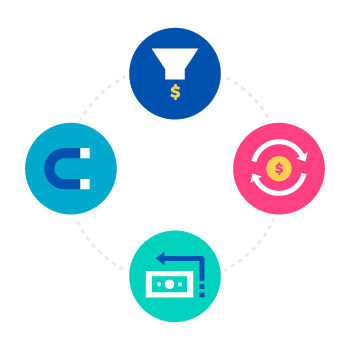The Secrets of ABM Programs: Here’s What You Need To Know About Account-Based Marketing

Contents
Your sales and marketing team are on a roll with researching, prospecting, and connecting with new leads. Your company has done a great job of identifying and serving your key customer segments, and your business has started expanding as a result. What can you do to keep your revenue stream growing, and maximize your team’s efficiency?
One of the best investments you can make as a company is in an account-based marketing program, which helps you quickly identify highly qualified leads and create personalized content specifically for them.
Account-based marketing, or ABM, should be used in tandem with a program that uses marketing automation, giving your employees more time than ever to focus their talent on the leads that really matter. By having a good ABM program and tracking the right metrics, your company can expand its reach exponentially, all while gathering crucial data about your customers and freeing up time to focus on other areas of the business.
In this article, we will discuss the basic concept of ABM strategy, how ABM programs can use automation to engage in this strategy, how ABM relies on personalized market content, and why this approach is so important for your marketing team, especially if you are a B2B company.
What is Account Based Marketing, Exactly?

Account-based marketing enables companies to create highly personalized marketing campaigns based on a certain account’s wants, needs, or interests. It is especially beneficial for B2B companies because, instead of having to market to millions of potential customers, they normally have a more targeted list of leads that require custom solutions.
The key is to get your leads reading your emails, and that is only achieved by providing highly personalized, relevant content through ABM. The numbers certainly stack up, as ABM achieves 208% more revenue than traditional marketing efforts.
How Can Account-Based Marketing Help My Marketing Team Strategize?
It is wonderful to have a growing buyer circle, but this often overwhelms sales and marketing teams. The key to success is to target high opportunity leads, which in turn enables your marketing team to create more effective automated marketing campaigns.
The result is that your company will have a focused group of high-spend leads that are happy to be receiving compelling and relevant content from your company, which is a win for everyone.
One example of ABM helping with overall marketing strategy is considering what platform your top prospects are using most often before engaging in marketing campaigns – for example, if they are present on Facebook and not on Twitter, it would make no sense to invest in Twitter ads. Similarly, if your target accounts are mostly operating in EST, it wouldn’t be helpful to send them a cold email at 11 PM EST.
However, always keep in mind that while ABM does wonders for generating sales and increasing revenue, it also has a very important role to play in your long-term growth.
The data that you will collect about account behavior, preferences and spending habits through ABM is vital to the continued success of future marketing campaigns.
For this reason, it is essential that your company have a cloud-based storage system that enables multiple users to access marketing information, digital assets, and client information. A storage plan based in the cloud, and preferably one that can link up to your CRM, is a good investment to keep all your data organized and easily retrievable.
A reliable cloud-based storage plan will enable your sales team and marketing team to work in tandem, which is absolutely required for successful ABM implementation.
How Does ABM Utilize Automation?
 How can highly personalized content work with automation?
How can highly personalized content work with automation?
Marketing automation plays a key role in gathering data about your customer segments, which then strengthens your ability to create personalized content.
Let’s say, for example, that you’ve managed to grab the attention of a top prospect with a well-crafted blog post about a subject that is highly interesting to this prospect. The prospect opens up the link, reads the post, then clicks on another link from your website. Through webpage tracking, you can see which product/service the prospect clicked on and auto-trigger a task for a sales rep to follow up via a business text or phone call.
Another great example of automation within ABM is seen in a cold email campaign.
With the ABM technique, marketers have done research and have compiled a list of targeted accounts that they work to create custom content for. This personalized content is the heart and soul of ABM, and of course, this part can’t be automated.
However, automation can save your coworkers from wasting time by automatically dropping in names, titles, company names, recent publications and more in an email template.
Marketing automation can track the click-through rate of the links within the email, and set up a trigger to send the reader another email specifically related to the item he or she displayed interest in. In spite of this focus on personalized content, 68% of ABM programs use automation to scale up outreach.
How Can I Use ABM to Target and Implement Personal Customer Communication and Engagement?
 First, your team must identify which accounts are most likely to be high-spend accounts. The results of this research will depend on how specialized your business is. For some businesses, this will be a handful of large companies, and for others, this will be a larger group of mid-sized companies within a small industry. Many ABM programs will help in this process, such as through tracking interest in particular products or services.
First, your team must identify which accounts are most likely to be high-spend accounts. The results of this research will depend on how specialized your business is. For some businesses, this will be a handful of large companies, and for others, this will be a larger group of mid-sized companies within a small industry. Many ABM programs will help in this process, such as through tracking interest in particular products or services.
Next, you must identify the decision-makers from each account, gather contact details for your email list, and organize these people by title or department. This is another task that ABM programs can assist with by searching within their database.
The next step is to create personalized content for each account, and if you want to go even further, you can create custom content for each person from within the account. Always keep in mind that, even though what motivates a CEO to make a decision might be different than what motivates a CFO to make a decision, the marketing content must aim to help the two reach consensus about buying your product.
Now that you have the list of targeted accounts, their key stakeholders and some incredible custom content, what is the next move? Do some research to see what channel is most likely to be effective when sending these communications out. CEOs are known to enjoy the use of LinkedIn, whereas a CFO might be more likely to respond to email. Once again, this is an area in which it is helpful to have an ABM program’s support.
Whether you use a program specifically for ABM or not, throughout this process, never forget the importance of gathering, storing and organizing the important data you will receive regarding these accounts.
These measurements will be important in optimizing your future marketing campaigns as well as measuring and comparing results. Email marketing, for instance, benefits especially from ABM approaches. In 2020, many of us have grown accustomed to receiving a large volume of marketing emails. Even though we often casually scroll past and/or delete these messages, email marketing still remains the most potent marketing tool of today’s digital landscape.
All in all, it’s clearly evident that ABM achieves results for B2B companies. While it does involve a lot of research, content creation and strategy, many of the more time-consuming elements of ABM can be automated through ABM programs. Relying on marketing automation when possible has the additional benefit of recording data about your prospects, which can be valuable to your long-term vision.
What Is a Sales Account Plan & What Part Does It Play in ABM)?
Because ABM is built around laser-targeted messaging, you need a central place to house all the critical details about your target accounts.
Without this “single source of truth,” it becomes much harder to effectively create highly personalized content.
And if you can’t create highly personalized content, you’re not really doing ABM at all – you’re just sending a bunch of mostly generic copy to a small number of accounts, which will never get you the ROI you need.
That “single source of truth” is your sales account plan. It should contain information like:
- Your target account’s decision-making process
- The companies you’re competing with to win their business
- Your overall strategy to close the
Think of it as a handbook that contains all the information you could possibly need to pitch successfully to your target accounts. It’s the one document that tells you everything about what makes your target account tick, such as:
- Who should you be making an effort to get to know? Who’s on the buying committee, and who are their key account stakeholders?
- What are their priorities right now? And how do those priorities relate to your product?
- Which channels should you be using to ensure that your content reaches the right people?
- How will your marketers and sales reps deliver the right level of support at each step of your ABM strategy?
- What likely objections would they have to buying your product right now?
How to Create an Effective Sales Account Plan
It should be clear by now why a sales account plan is a vital part of your ABM strategy. Now here’s how to build one that works:
1. Identify Which Accounts Require a Detailed Plan
There’s no getting away from the fact that, even though it’s important, sales account planning can eat up a lot of time and resources.
For that matter, so does ABM.
Before you embark on an ABM strategy, you need to ensure that the potential reward is worth all the upfront investment in lead nurturing and content creation.
For smaller accounts, the ROI just isn’t there – which means they simply don’t need a sales account plan.
2. Perform Your Account Analysis
So you’ve established that the account in question does require a sales account plan.
Now it’s time to gather and dig into the data to understand what those accounts want (and where your product fits in). Specifically, you’ll be finding out:
- Their business goals
- Their biggest focus right now
- The name(s) of their decision-maker(s)
- Their current process for achieving the “thing” that your product does
- How your product compares against other potential options
You’ll likely need to use a bunch of sources to gather all that information. General company information should be available on LinkedIn, as well as via their website and press collateral. For anything more specific, you’ll probably have to ask them directly.
3. Make Your Data Actionable
You’ve got all the data you need – congratulations!
But remember, you’re not writing a biography of your target account. You’re building a strategic plan. And that data is more or less worthless without insight and action attached.
Based on your analysis of all the available information, what’s the biggest thing you should be doing right now to engage this account and demonstrate your value?
How about in the next 30 or 90 days?
For instance, maybe in that first month or two, you’ll want to focus on building brand awareness among key decision-makers through market reports, trend pieces, or interviews with thought leaders in their space. Then around month three, you’ll start to discuss your product through informative videos, guides, and case studies.
If this is a really big account that justifies such a lengthy sales cycle, you’ll want to look even further afield too – to a year, or even two years, down the line.
4. Execute Your Sales Account Plan
Now it’s time to apply all the information you’ve gathered by pulling the trigger on your ABM strategy.
To start, your “opener” – whether it’s an email, a phone call, a LinkedIn InMail message, or something else entirely – should be crafted by someone who fully understands the account.
That knowledge should be immediately obvious to your target account. It could look something like this:
- I saw that you’ve just opened an office in Atlanta…
- I noticed you’re currently hiring for a CMO…
- I found out that your biggest rival is about to launch a new product…
- From the information I’ve gathered, it looks like your biggest objectives are X, Y and Z, is that right?
How to measure your account based marketing efforts
There’s a lot more to measuring your ABM metrics than just setting KPI’s. You need to be strategic about how you create the process of tracking metrics before you get started. Two things you must do before you starting tracking data are setting your metrics before you get started and automating the process.
1. Set your metrics before you begin
One of the biggest mistakes people make when creating an account based marketing strategy is forgetting to set metrics before putting the plan into place. Why is this an issue? The same reason that you wouldn’t start a science experiment without first forming a hypothesis.
Establishing what success looks like before you launch your new ABM strategy helps your team quickly discover what is working and what isn’t. When you have data without a hypothesis, you can mold the data to fit whatever narrative you want. And while that might help you look good in front of your boss, it doesn’t help improve the customer experience.
How do you measure metrics once you choose them?
Once you’ve decided on which metrics to target, you can turn your attention to tracking them. It is possible to measure this all manually in spreadsheets but that can be a huge time-suck. Most professionals will use a CRM software to track all of their ABM efforts.
According to G2’s Fall 2019 CRM Grid Report, 86% of CRM software customers say that the product they use meets the necessary requirements needed to support their marketing strategy.
Why is that number so high? It’s because CRM software does it all. It allows the user create an established set of sales-related functions, track key accounts throughout the sales pipeline, and manage all of the data around your pre-determined KPI’s in a single location.
2. Automate the little things
You can probably tell that account based marketing isn’t something you do halfway, it’s all or nothing. That’s why it’s so important to automate as much of the process as possible. This allows your team to focus on the big picture stuff and gives you more time to connect with your potential customers. A lot of companies opt to use marketing automation software for this part of the process.
Jonathan Herrick, CEO of BenchmarkONE, a marketing automation and CRM platform, believes in the power of automation when it comes to account-based marketing. “With marketing automation software, you can optimize and personalize your workflows. This ensures that even if you have a large amount of key accounts you’re targeting, each is sent content that serves their particular needs with relevant messaging, and none of those valuable leads get neglected.”
How to automate your ABM strategy
According to G2’s Fall 2019 Marketing Automation Grid Report, 88% of marketing automation software customers say that the product they use meets the necessary requirements needed to support their marketing strategy. The best part? That same report showed that customers saw an expected ROI after just 10 months of implementation.
Marketing automation is great for both automation and A/B testing, which is crucial for anyone building an account based marketing strategy as they go. You can eliminate the guesswork and the grunt work by automating the little things that usually eat away at your time.
Marketing automation software solutions also give users the option to:
- Generate forms and landing pages to collect prospect information
- Contact targets across multiple channels after specific actions, triggers or periods of time
- Perform lead management to include lead nurturing and lead scoring
Once you’ve got things automated, the fun begins. You can use these marketing automation software solutions to remarket customers who may have missed your messaging the first time around. This helps you get the most bang for your buck and snag the attention of those key accounts.
4 ABM metrics your team needs to track
Now that you have the methodology and data-tracking details all ironed out, it’s time to decide what you’re going to track the success of your ABM campaign. This is crucial to the health of your account based marketing program. When people outside your team ask you to prove the success of program, these metrics will help.
1. Influenced Revenue
There are several touch-points along the sales funnel that influence decisions a customer makes but that’s not to say everyone gets the credit they deserve. If someone reads a blog post of yours and ultimately becomes a customer, your content helped influence that revenue.
It might seem like a small piece of the pie, ABM is all about the collective effort of the team. Every email sent to a prospect, every blog post read by a potential customer, and every webinar they sign-up for is part of the ABM lifecycle. Tracking your highest touchpoints that convert toward revenue will help you tailor your program to convert leads faster while spending less money.
2. Sales cycle length
Account based marketing is designed with the goal of speeding up the sales pipeline. Start by pinpointing the average length a customer spends in the sales cycle and then aim to speed that process up. It can be easy to get caught up in the ideas you have for creating custom content for potential customers and lose sight of the end goal.
If your ABM strategy prolongs the time it takes to close deals, you’re actually doing more harm than good. Or worse yet, maybe your ABM strategy actually causes a potential customer to hesitate and pull out of a deal. These things are important to keep an eye on as you get your ABM strategy up and running.
3. Return on Investment
It might seem like a good strategy to target the biggest accounts worth the most money but that might not be the right strategy. If it costs you more money to acquire a customer than it does on the money you make on a closed deal, you’ve wasted your efforts. The ROI of customer acquisition is crucial: which is why it’s important to focus on targeting the right customers.
How to determine your ideal customer
Account based marketing works when you focus on your ideal customer. An ideal customer isn’t simply who will bring in the most revenue. In fact, there are several factors to consider when deciding which accounts to target when your ABM strategy.

The best customers stay with your company for an extended period of time, don’t have extraneous customer support needs, and will advocate for your brand using word of mouth marketing. An easy way to pinpoint who these customers are is by creating a customer profile.
Having an all-in-one CRM gives you access to customer data at a moment’s notice. You can track everything from company size and geolocation to what content they engage with on your website and which emails they click through. These key insights can tell you who your ideal buyer is and therefore which kinds of accounts you should be targeting in the future.
4. Customer retention
All of these efforts mean nothing if you lose a new customer once their contract expires. You need to continue to delight your customers once you’ve won their business and stay in contact through relationship management or even email newsletters. Tracking how many of your customers stick around can show you where the weaknesses in your ABM strategy are.
Did your customers feel as though you didn’t keep your end of the bargain? Did the product not do what they were promised? Why are you losing new business? These are the questions to ask while tracking customer retention.
And it’s not just about retaining new customers, ultimately your sales team is going to want to upsell these customers into more deluxe offerings. How does your ABM strategy help close these deals and upsell key accounts? This is just as important to track as new business acquired.
Summary
As always, understanding your customers and providing stellar content and effective marketing campaigns is vital to the success of your business, and this part can never be automated.
Thankfully, many of the more administrative and data-oriented tasks can now be handled by automation through ABM programs, freeing up your sales and marketing team’s time to focus on what they do best: connecting with your audience and sealing the deal.





